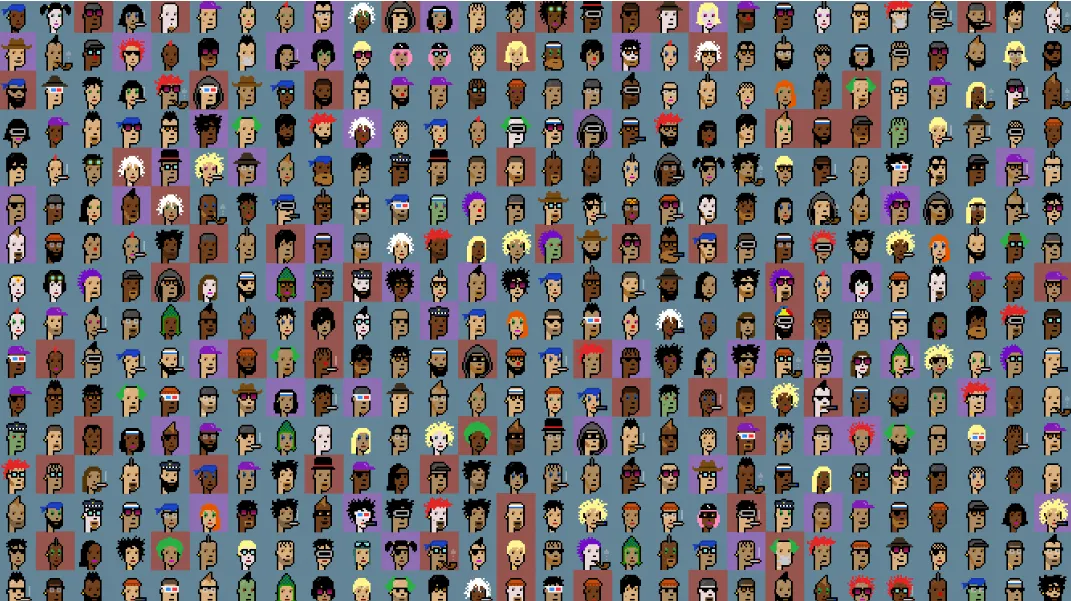About the author
Jean-Christophe Camuset, a senior editor for ELLE Décor France, is a Paris-based journalist and curator with a flair for design, art, and tech.
The views expressed here are his own and do not necessarily represent those of Decrypt.
Article courtesy of Club CPG (@clubcpg)
The story of the most iconic project in crypto-art begins in a gloomy neighborhood in Brooklyn. “The most polluted waterway in the whole country,” Matt Hall says of the surroundings that inspired his work with Larva Labs co-founder John Watkinson in the new documentary “What the Punk.”
This 80-minute tale of counterculture follows two humble Canadian programmers who started experimenting with tech and art in 2005, and are now featured in Centre Pompidou in Paris, where CryptoPunk #110—donated by current IP owner Yuga Labs—has been exhibited since 2023.
In the late 2000s, while developing mobile apps, Hall and Watkinson started working on the Pixel Character Generator, a fun feature to create unique profile pictures with overlays of basic pixelated elements.
Then came the rise of Ethereum. As long-time sports card collectors, they sensed that the blockchain offered huge development potential that could help them create a digital equivalent to their childhood passion: a new kind of collectible.
WHAT THE PUNK! - Official Trailer (2024)
With @larvalabs @pents90 @matthall2000 @ROBNESSOFFICIAL @ArtOnBlockchain @Grandenchilada @Tschuuuuly @noah0x0 @DanPolko @JasonAbbruzzese @soldthebottom @MartinDelpierre @TokenAngels @johnkarp pic.twitter.com/zD2Ej9kSgW
— What the punk! (@WTP_Movie) February 21, 2024
Composed of 10,000 algorithmically generated pixel images with 87 unique attributes, CryptoPunks inspired the ERC-721 standard and gave birth to the profile picture (PFP) movement that later spread through Yuga’s Bored Ape Yacht Club and countless other spiritual successors.
Matt Hall and John Watkinson launched CryptoPunks in June 2017. The first week, the release went mostly unnoticed in the proto art-tech community. But a Mashable article drew attention to the free claim. In a matter of days, the whole supply was minted out.
Secondary sales gradually gained momentum, eventually yielding a number of sales in excess of $10 million worth of ETH. The hype and influx of money would help drive the emerging scene of NFTs.
“What The Punk” gathers some of the most prominent personalities who have helped propel blockchain momentum in art history: former Christie's digital art lead Noah Davis (who went on to head up CryptoPunks under Yuga), art expert Yehudit Mam from Dada, collector Dan Polko, and longtime Punk Discord moderator Tschuuuly.
Erick “Snowfro” Calderon also acknowledges how his experience as a Punk collector and active community member helped him envision Art Blocks, the successful Ethereum generative art platform.
As a counterpoint, “What The Punk” highlights the practice of Robness, an early crypto-artist. Robness disapproved of the hype around CryptoPunks, which stole attention from the artistic aspect of the project to fuel speculative investments. So in 2021, he bought the Punk #2317 and immediately burned it as an art gesture.
Still in love with the artistic core of the project, Robness coined Punks “the Warhol of crypto art,” adding that it represented “a movement—we’re just at the beginning of it.”
Behind the film
Hooked by the story of the CryptoPunks, director Hervé Martin-Delpierre—who previously helmed “Daft Punk Unchained”—and producer Marc Lustigman spent three years uncovering the secrets behind the Punks and interviewing big names in crypto art. From artists to gallery owners, collectors to auctioneers, they’ve captured a rich tapestry of voices that reveal how this collection revolutionized the art world.
Lustigman told Decrypt that the concept for the documentary came amid the Covid-19 pandemic in 2020, before the NFT craze of 2021 that supercharged Punks prices.
“A friend told me, ‘This is the future of art; you should buy some.’ At first, I thought he was joking,” Lustigman recalled. “I was only focused on the visuals. Gradually, something started to draw me in, even obsess me! Six months later, I grasped the genius behind it, and the story I uncovered was so wild that I wanted to make a film about it.”
“It was the Punks that introduced us to crypto art,” Martin-Delpierre added, noting that their use of smart contracts to enable on-chain art projects “enabled digital art to flourish. They are behind the genesis of what followed: the development of an entire artistic ecosystem.”
The filmmakers purposely avoided getting mired in the technicalities of the blockchain, instead focusing on the impact of CryptoPunks, both supporting and dissenting voices, and the growing reach of the collection within the traditional art world. Even so, there were some quirky elements to explain, such as the glitched “V1 Punks” that were abandoned and replaced, yet continue to exist on the blockchain.
“The challenge was explaining extremely complex things—like the V1 Punks—to people unfamiliar with [the crypto] world,” said Martin-Delpierre. “We sought the right narrative form to do this because these key moments help [people] better understand how art functions on the blockchain. This isn't a film about the Punks; it's about the journey of three contemporary artists.”
“From the start, we wanted to go beyond a simple success story, to delve deeper into the development of art on the blockchain,” Lustigman added. “Robness joined midway and echoed Matt and John's trajectory: artists fighting for their art to be seen and recognized. He acts as a catalyst.”
WTP ✊✨ pic.twitter.com/3wdCWqGroe
— NotWarren 🤍 (@notwarrenETH) June 12, 2024
CryptoPunks launched before most poeple knew what NFTs were, then blew up and generated billions of dollars in trading volume—but have seen cooling trading momentum over the last couple years, despite the occasional huge sale that still turns heads and grabs headlines. The documentary covers the highs and lows amid that rollercoaster trajectory.
As filmmakers, they were also tasked with telling a story of a relatively niche project—aiming to both honor and satisfy that community of fans while also expanding its reach and bring that story to a much wider audience.
“As documentarians, we take a broad view and ask questions,” they said in a joint response. “We are neither pro nor anti-NFT. We simply want to provide this material to the general public—so they can form their own opinions without cultural biases. This film is a snapshot of our time: Creative, somewhat naïve people being either swallowed up or fighting against overwhelming forces.”
“What the Punk” was released internationally on June 11 on VIMEO OTT for a limited 3-month period and on ARTE in France and Germany. The European Premiere was held on June 11 during Art Basel 2024, as part of Digital Art Mile, a new digital art fair format in Basel.
Edited by Andrew Hayward

